Meet our current MRM-ers!

Ana Sofia Barrera
barranas@oregonstate.edu
Advisor: Kirsten Grorud-Colvert
marine protected areas • conservation • coastal communities
Originally from Mexico City, I got my undergraduate degree in General Biology and Marine Science at UC San Diego. Although Mexico City is far from the ocean, I grew up visiting the Pacific coast very often. As such, I became extremely fond of the cultural and social practices surrounding my country's coastline. This fondness ties into my current research, which involves looking at the intersections between community and environmental well-being throughout coastal Mexico through the lens of area-based management. My long-term goal is to return home and work in marine conservation to develop and implement sustainable practices in collaboration with local communities.
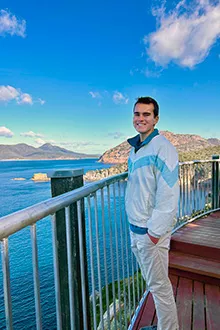
Jace Bell
belljace@oregonstate.edu
Advisor: Steve Dundas
economics • climate change • coastal ecosystems • managed retreat
I grew up and did my undergraduate degree over a thousand miles from any ocean. However, my lifelong fascination with the sea, study abroad experiences in Costa Rica and Australia, and a strong interest in the linkages between science and management led me to MRM. My research at OSU concerns the economic dimensions of managed retreat in a changing climate with a long-term goal of working to bridge the gap between marine science and policy.
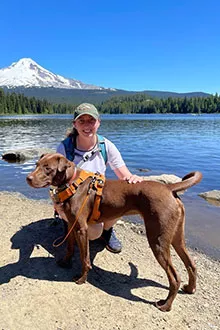
Hannah Brachfeld
hannah.brachfeld@oregonstate.edu
Advisor: Hilary Boudet
renewable energy • offshore wind • ocean policy
After graduating with a B.S. in Chemistry from Loyola University of Chicago, I earned a commission in the United States Navy as a Surface Warfare Officer, serving on two ships and earning the title of Nuclear Engineering Officer. This led me to my current research investigating Department of Defense and Coast Guard involvement in Marine Renewable Energy siting and policy, with a focus on offshore wind energy off the coast of Oregon and Virginia. My goals are to transition from an active duty military role to a policy-focused renewable energy position, combine skills from my military experience and the interdisciplinary MRM program, and work as part of a team to fight for a cleaner future for everyone.
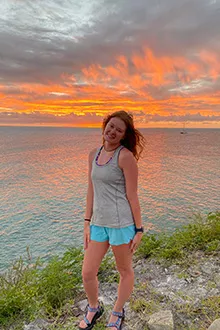
Rhiannon Carlile
carliler@oregonstate.edu
Advisor: Lorenzo Ciannelli
climate change • coastal communities • fisheries
I am from Papillion, Nebraska and received my bachelor’s degree in environmental science from the University of Nebraska-Lincoln. My focus during undergrad was freshwater systems until I studied abroad in the Turks and Caicos Islands where I learned about the implications of management in tropical marine ecosystems. My research interests currently include the impacts of the spatial distribution of west coast groundfish on management and coastal communities. My goal for the future is to pursue a Ph.D. in a similar field and either stay in academia, or work for a federal agency like NOAA. I hope to be a bridge between natural and social science where I can work to improve the management of natural resources for the benefit of the environment and human society.
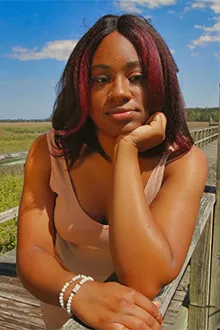
Savannah Clax
claxs@oregonstate.edu
Advisor: Jessica Miller
climate change • fisheries • hypoxia
Originally from the midwest, I attended Savannah State University where I earned a B.S. in Marine Sciences. During my time as an undergrad, I got involved in research regarding otoliths and climate impacts. My current research combines these two topics as I look at the effects of hypoxia and temperature on Petrale Sole growth using otoliths. My future goals include working in coastal resource management and finding better ways marine science can be communicated to the general public.
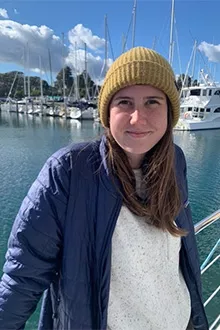
Jessica Cunningham
cunnijes@oregonstate.edu
Advisor: Sarah Gravem and Bruce Menge
conservation • education • policy • restoration
I grew up in Lodi, an agricultural town in Northern California. I attended UC Santa Barbara, earning a B.S. in Physical Geography with an Ocean Science emphasis and minor in Earth Science. My research interests encompass marine ecosystem restoration and science communication outreach. I am currently working with the Oregon Kelp Alliance to calculate the catch per unit effort of purple sea urchin removal methods and their impacts on purple sea urchin and bull kelp densities to help inform future resource allocation for kelp forest restoration in Oregon and to better understand grazer control efficiency. My ultimate goal is to bridge the gaps between technical science and communities in ways that empower future generations to make informed decisions.
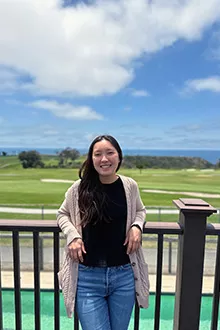
Miriam Hauer-Jensen
hauerjem@oregonstate.edu
Advisor: Kate Stafford
policy • noise pollution • climate change • marine mammal acoustics
I am from Little Rock, Arkansas and received my bachelor's degree in Organismal Biology with a minor in music at Scripps College. In undergrad, I joined a lab studying the impact of temperature change on barnacle metabolism through feeding experiments. I also spent several summers studying marine mammal vocalizations in the Southern Ocean to determine species presence and distribution. My current research will focus on studying bearded seal and walrus vocalizations in the Chukchi Sea in the midst of retreating sea ice. My goal is to work on solutions and advocate for policies that protect marine life from the negative impacts of anthropogenic noise and climate change.
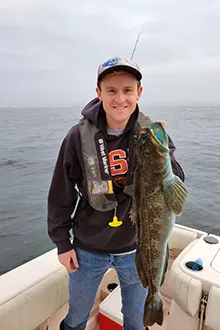
Dylan Heppell
heppelld@oregonstate.edu
Advisor: Mark Lomeli
bycatch • conservation • fisheries
Born and raised in Oregon, I attended Oregon State University where I earned a B.S. in environmental sciences with a specialization in aquatic biology. As an undergraduate I studied the correlation between coralline algae cover and species richness in Oregon coast tidepools. After graduating, I spent a year living in Florida working for Reef Environmental Education Foundation. While there, I worked on a variety of scientific projects but was primarily focused on removal of invasive lionfish. My current MRM research is centered around bycatch reduction in the halibut longline and bottom trawl fisheries on the west coast. My long-term goals are to work closely with conservationists and stakeholders to find conservation solutions that can be a benefit to all.

Emily Hicks
morrowe@oregonstate.edu
Advisor: Tracy Crews
invasive species • aquaculture • oysters • biosecurity
I am studying the perceptions held by consumers and growers towards the invasive mud blister worm (Polydora spp.) in PNW estuaries. I'm also working on projects with Oregon Sea Grant on the impacts of a herpes virus on Oregon aquaculture, as well as national campus biosecurity policies. After graduation, I hope to continue working on campus biosecurity, as well as with oysters and invasive species. I live in Veneta, OR with my life partner, daughter, and cats. In my free time, I enjoy bicycling, hiking, reading scifi and fantasy, quilting, knitting, and baking.

Jamon Jordan
jordjamo@oregonstate.edu
Advisor: Maria Kavanaugh
climate change • fisheries • national marine sanctuaries
Born and raised in GA, my love for fish began early, fishing with my dad from age two. In middle school, my goal was set: work for NOAA. I earned a degree from the University of Georgia in Fisheries, Wildlife, and Natural Resources Management with an emphasis on Aquatic Science and GIS. Combining my interests in fish, spatial ecology, and remote sensing, I'm currently researching habitat distributions of swordfish in the proposed Chumash National Marine Sanctuary in California. My ultimate aim remains joining NOAA, with a growing interest in bridging policy and research for oceanic remote sensing.
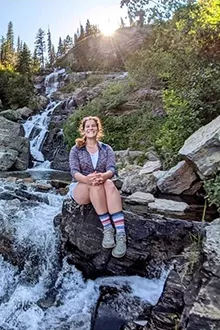
Kelsey Lank
lankk@oregonstate.edu
Advisor: Tracy Crews
science communication • policy • coastal communities
I grew up in Michigan and received my B.S in Environmental Engineering from Michigan Technological University. When I graduated, I preferred my water bodies "unsalted and shark-free," but this changed when I began working in the dredging/marine construction industry. As I completed beach renourishment and harbor/port deepening projects, I became much more aware of the need for greater transparency and communication between technical experts and communities. This led me to MRM where I will be researching best practices for making technical information "digestible" to coastal communities, including scalable programs that support communities to influence policy. My career goal is to support coastal communities, especially underserved communities, through a position at a nonprofit or in coastal management.

Brandon Lindsey
lindsbra@oregonstate.edu
Advisor: Sam Chan
invasive species • shellfish industry • policy
Having been exposed to SCUBA at a young age and witnessing the lionfish invasion among Caribbean reefs, I became very interested in the cascading effect of invasives and pursuing marine research. After receiving a B.A. in Evolutionary Biology and Ecology from the University of Colorado Boulder, I found it hard to leave the mountains, where I spent my summers focused on invasive plants, freshwater fish, and stream morphology, while winters were focused on snagging first tracks in the high country. I now am thrilled to be returning to the ocean to study the invasive European green crab, a species of concern for the PNW shellfish industry and Oregon’s economy more broadly. After grad school, I hope to continue invasive species work through a nonprofit or government agency such as NOAA, helping to influence policymakers and keep our fisheries sustainable.
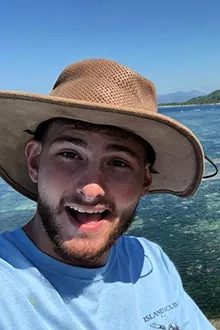
Matthew Noto
notom@oregonstate.edu
Advisor: Jessica Garwood
coastal communities • dunes • human dimensions
Born in Brooksville, Florida, a small country town at the start of the Floridian Panhandle, I started my working career working drywall and framing until I decided to go to the University of South Florida for Geology in 2013. My undergraduate degree led me to develop an interest in Hydrogeology, which led to a career with Geosyntec Consultants. After three and a half years, I joined the Peace Corps in the Philippines as a Marine Resource Management Volunteer. Due to COVID-19 I was evacuated and found myself in the Keys working on marine debris. After a brief stint, I moved to Korea, Montana, and other parts of the world developing an interest in Social Science and Conservation Marketing. This has led me to the Marine Resource Management program at OSU, where I am studying the values and perceptions of communities along the Oregon Coast toward dunes. My ultimate goal is to start my own company as an environmental and conservation marketer, and possibly one day create documentaries as a medium to share scientists’ information with the public.

Diania Remy
remyd@oregonstate.edu
Advisor: Karen McLeod
diversity, equity, and inclusion • STEM education • policy
Born and raised in Miami, Florida, my deep connection to the ocean is rooted in my Caribbean heritage. I earned a B.S. from Florida State University, where I developed a passion for marine education and advocacy. Following graduation, I worked with the Office of STEM Teaching Activities, teaching K–12 students about the wonders of the ocean and the importance of environmental stewardship. My current research focuses on the shifting landscape of Diversity, Equity, and Inclusion policies in today’s political climate in the US. I document the narratives of professionals who are resisting, adapting to, and overcoming these changes within academic and professional spaces. In my free time, I enjoy gardening, visiting wineries, and studying new languages.
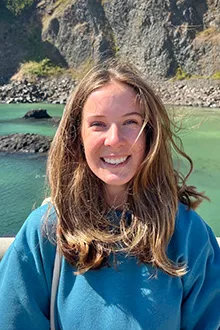
Lauren Rice
ricela@oregonstate.edu
Co-Advisors: Karen McLeod and Ana Spalding
adaptive capacity • climate change • coastal communities • ocean acidification
Having (mostly) always lived near the Oregon coast, I feel instinctively motivated to conserve oceans and the livelihoods of those relying upon them. As I pursued a B.S. in Marine Studies and a psychology minor as an undergraduate, I developed a passion for studying how social and oceanographic processes mutually influence each other. This led me to MRM where I am researching the capacity of U.S. West Coast commercial shellfish farmers/harvesters to adapt to various stressors. Alongside adaptive capacity, my interests include social psychology, ocean acidification, and education & outreach. My long-term goals include becoming a conservation social scientist, contributing to applied community-based research efforts, and keeping my massive houseplant collection alive!

Chandra Schulte
schulcha@oregonstate.edu
Advisor: Jennifer Fehrenbacher
climate change • marine calcifiers • ocean acidification
Prior to moving to Oregon, I lived in Florida for nearly a decade where I earned a B.S. degree in Aquatic and Marine Biology from Stetson University and worked at corporate and local government environmental and drinking water laboratories. My time working as a professional scientist sparked my interest in chemistry and the role it has in marine ecosystems. My current research focuses on foraminifera, a calcifying marine plankton, and the impacts of ocean acidification (OA) on these organisms. OA is a consequence of climate change that impacts marine ecosystems, coastal communities, and fisheries. My goal is to establish baseline information on foraminifera and OA off the coast of Oregon. Ultimately I hope to contribute to the understanding of OA and share this knowledge with environmental managers and policy makers.
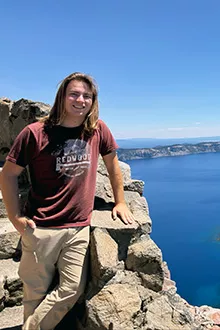
Adam Shokes
shokesa@oregonstate.edu
Advisor: Sam Chan
red seaweed • urchins • cultivation • conservation
Born and raised in Charleston, South Carolina, I spent my time in undergrad earning my B.S in Packaging Science at Clemson University with the goal of helping to reduce plastic waste output. After realizing I wanted to take a more direct path toward marine research, I made the decision to come to the MRM Program, where I will be focusing my research on the cultivation of red algae and urchins collected from urchin barrens. I'm excited expand my knowledge of these species with an eye to pursuing research or further education.
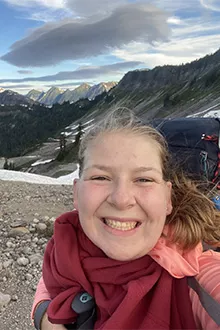
Jenna Travers
travejen@oregonstate.edu
Advisor: Michael Harte
climate change • fisheries • invasive species • policy • socioeconomic impacts
Growing up bouncing between living on the east and west coast, I developed a love of oceans, marine animals, and coastal communities from a young age. I earned my B.S. in Marine Biology at the University of Oregon where I studied the impacts of glacier retreat on salmon populations and the communities that rely on them before transitioning to Oregon State University's MRM program to continue my work studying the impacts of salmon declines and invasions on communities. My current research uses a mixed methods approach to evaluate the socioeconomic, policy, and genetic implications of bioinvasive populations of Pacific salmon in the Alaskan Arctic and Chilean Antarctic/Falkland Islands with Michael Harte. I have worked as an intern with local environmental nonprofits, the Oregon state legislature, and the US Forest Service on environmental management and policy issues, and I currently work as a writer for GlacierHub, a news organization that covers glaciers and mountain communities. My long-term goal is to work in watershed management with a nonprofit or government agency, taking a holistic and community-led approach to manage the entire watershed from mountains to estuaries.

Michael (Mick) Weingartner
weingarm@oregonstate.edu
Advisor: Angee Doerr
food production • invasive species • management • policy
Originally from Alaska, I grew up with a deep respect for and interest in human interactions with marine systems. I spent five years in Washington, DC working first for a climate change nonprofit, then for a member of Congress in the Senate across a wide range of legislative policies. Before coming to Oregon State University, I also spent two years working for an algae aquaculture operation where I developed an interest and experience in marine food production. My research interests include the human side of coastal resource management, and my current research involves assessing the needs and priorities of coastal stakeholders in the management of the invasive green crab (C. maenas). My long-term goals are to contribute to the development of state and/or federal policies at the nexus of climate change impacts, marine ecosystems, and food production.

Taylor Wood
woodtay@oregonstate.edu
Advisor: Maria Kavanaugh
conservation • harmful algal blooms • cooperative fisheries
I’m originally from Chicago but moved to the Oregon coast after graduating from Oklahoma State University with a B.S. in Zoology. I’ve worked throughout Oregon studying marine ecology and specializing in environmental education and science communication. My work with the central coast conservation community led me to the MRM program, where I am studying the presence of harmful algal blooms off the Oregon coast through collaboration with a cooperative fisheries research network. My goal is to work at the intersection of ecological research and marine conservation, while focusing on integrating local communities into the adaptive management process. I also explore my love of the marine environment through surfing and creating ocean-inspired art.
Go to the Marine Resource Management Program page.